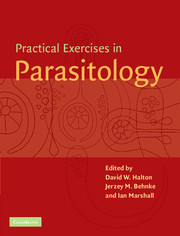Book contents
- Frontmatter
- Contents
- List of contributors
- Preface
- General advice
- 1 Observational Exercises on Parasites
- 2 Ecology
- 3 Physiology and Biochemistry
- 3.1 Hatching in vitro of oncospheres/hexacanth larvae of Hymenolepis diminuta
- 3.2 Activation of the cysticercoids of Hymenolepis species in vitro
- 3.3 Membrane transport in the cestode Hymenolepis diminuta, in vitro
- 3.4 Glycogen utilisation and deposition in flatworm parasites
- 3.5 Effects of classical transmitters on the motility of parasitic roundworms and flatworms
- 3.6 Electrophysiology of Ascaris suum body muscle
- 3.7 Immunocytochemical localisation of neuroactive substances in helminth parasites
- 4 Pathology and Immunology
- 5 Chemotherapy
- 6 Molecular Parasitology
- 7 Behaviour
- Appendix 1 Reagent index
- Appendix 2 UK suppliers
- Appendix 3 US suppliers
- Index
3.1 - Hatching in vitro of oncospheres/hexacanth larvae of Hymenolepis diminuta
Published online by Cambridge University Press: 05 June 2012
- Frontmatter
- Contents
- List of contributors
- Preface
- General advice
- 1 Observational Exercises on Parasites
- 2 Ecology
- 3 Physiology and Biochemistry
- 3.1 Hatching in vitro of oncospheres/hexacanth larvae of Hymenolepis diminuta
- 3.2 Activation of the cysticercoids of Hymenolepis species in vitro
- 3.3 Membrane transport in the cestode Hymenolepis diminuta, in vitro
- 3.4 Glycogen utilisation and deposition in flatworm parasites
- 3.5 Effects of classical transmitters on the motility of parasitic roundworms and flatworms
- 3.6 Electrophysiology of Ascaris suum body muscle
- 3.7 Immunocytochemical localisation of neuroactive substances in helminth parasites
- 4 Pathology and Immunology
- 5 Chemotherapy
- 6 Molecular Parasitology
- 7 Behaviour
- Appendix 1 Reagent index
- Appendix 2 UK suppliers
- Appendix 3 US suppliers
- Index
Summary
Aims
This exercise is designed to demonstrate:
The importance of various physicochemical factors in the activation and hatching of the oncosphere/hexacanth via dis-solution of the embryophore.
The behaviour of freshly hatched larvae.
Introduction
Hymenolepis diminuta is a tapeworm of rodents (for life cycle, see Exercise 1.14). Hymenolepis eggs (Fig. 3.1.1) contain a single oncosphere/ hexacanth larva (six hooks). These eggs are infective to the beetles Tenebrio and Tribolium.
Sources of parasite material
A small number of infected rats held in one or two institutions of higher education can provide enough tapeworm eggs to supply large practical classes run at many other institutions. Eggs remain infective in faeces for several weeks and can be supplied by post from those universities and institutions that maintain the infections. Faeces should be refrigerated on arrival. See also Additional information in Exercise 1.14.
Safety
This exercise is entirely safe for humans since the eggs are only infectious to beetles! Tapeworm eggs will have been thoroughly washed and students will normally only touch the sides of clean microscope slides. It is good laboratory practice to ensure that hand to mouth movements do not occur and that students wash their hands and use a nail-brush before leaving the laboratory.
- Type
- Chapter
- Information
- Practical Exercises in Parasitology , pp. 175 - 182Publisher: Cambridge University PressPrint publication year: 2001

